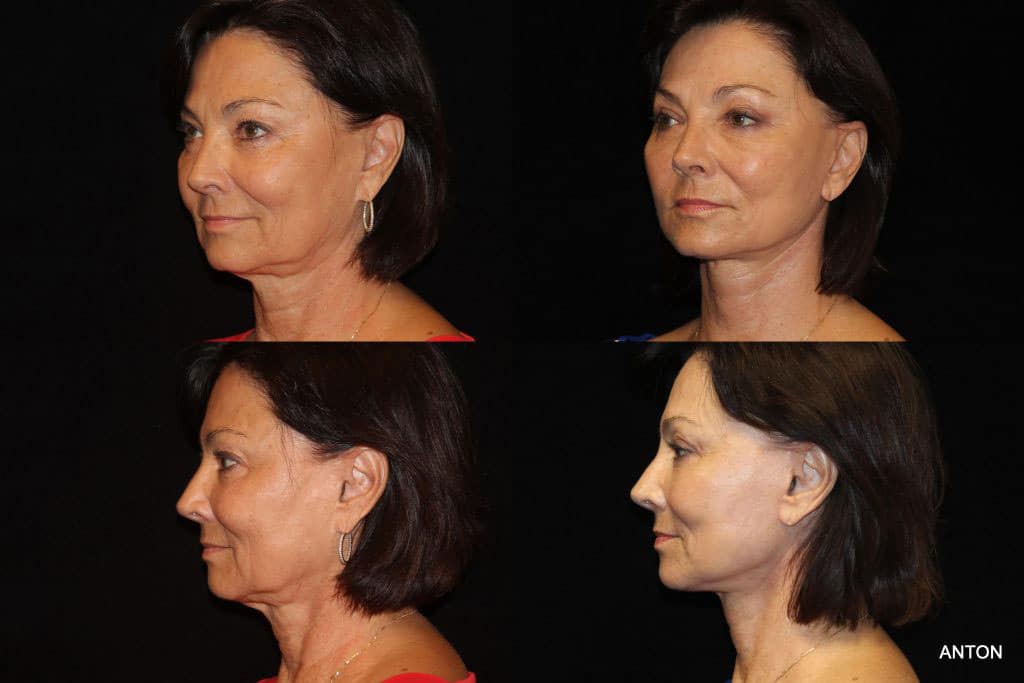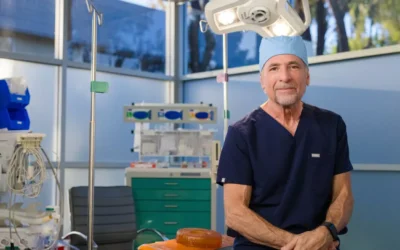It’s that time of year again. Reset. Refresh. Rejuvenate. For some that means considering plastic surgery to improve their appearance.
Facial cosmetic procedures are more popular today than ever before. As lifestyles improve and people live longer, healthier lives they want to look as good as they feel.
In 2019 Dr. Anton performed more facelifts than two times the national average, according to American Society of Plastic Surgeon (ASPS) statistics. Plastic surgeons are specialists in combining art, science and innovation and facelifts are the hallmark of a surgeon’s abilities. Your face is your calling card to the world. Selecting the right surgeon is a critical step in achieving your desired outcome.
In addition to being Board Certified by the American Board of Medical Specialties, Dr. Anton received advanced training by completing a Facial Fellowship. This training provides him with an unrivaled understanding of the anatomy and aesthetics of the face, qualities that are essential for creating facelifts with natural results.

A Picture is Worth a Thousand Words
There is a lot of hype in plastic surgery, especially when it comes to facelifts. Everyone wants the impossible – a surgical result without surgery. Despite the numerous marketing spins on non-surgical skin tightening devices and techniques, nothing delivers the results of a facelift…at least not yet.
Sometimes it’s hard for a patient to distinguish between a good PR campaign and a good MD, or in this case plastic surgeon. Many of Dr. Anton’s patients are referrals from other doctors, hairdressers, estheticians, other beauty technicians, and previous patients happy with their facelift results.
Still a good number of patients learn about Dr. Anton from the internet and review sites like Real Self, where they can see for themselves in Before and After photos, his ability to deliver natural facelift results. No filters. No Photoshop. Dr. Anton is meticulous in how his photos are taken so they don’t in any way misrepresent his work or misinform potential patients.
Dr. Anton’s Facial Fellowship training along with having received the highest grade in his medical school anatomy class prepared him for delivering natural facelift results and more importantly minimizing the risks of surgery. As with any surgery there are risks involved. During a consultation Dr. Anton discusses those risks and how he is able to mitigate them.
Perhaps this is your year to consider a facelift. Dr. Anton’s consultations are very thorough. He discusses the surgery in great detail so that his patients have a realistic expectation. Surgeons techniques, skill, expertise and artistic abilities can vary dramatically.
Facelift FAQs
-
What is the right age for a facelift?
Many people might answer late 50s or early 60s. Truth is, there is no perfect age for a facelift, but the trend now is for more women and men to have a facelift in late 40s and early 50s. There are a lot of factors for this with social media being a big one, but so is staying competitive in the job and dating market. As people take better care of their health with proper nutrition, exercise, supplements, bio-identical hormones, and mindfulness we are extending the youthfulness of our bodies by decades. Naturally, people want to look as good as they feel. Unfortunately, gravity does not always cooperate. A facelift restores youthfulness by removing sags and bags that cannot be addressed with non-surgical tightening devices or injectables.
-
Does it hurt?
Pain is difficult to determine due to individual pain thresholds being quite different. There does seem to be this misnomer that a facelift really hurts and that is just not the case for Dr. Anton’s patients. Many patients don’t need any pain meds after the first night.
A realistic expectation is that pain will be mild to moderate 4 to 5 days after surgery. By following the pre and post-instructions and administering pain medications as directed or as needed, most patients report very little discomfort. The most common complaint is pain behind the ears.
-
What is the difference between a lower facelift, a necklift and a facelift?
Basically, not much. These differences refer back to the spin out there and a lot of doctors trying to brand their procedure as something new and different. A necklift sounds less invasive than a facelift and the market is responding to what consumers want to hear.
A facelift, no matter how you brand it, addresses loose tissue in the neck, jowls, and mid-face. Dr. Anton performs what he calls a two-layer facelift. He first dissects the SMAS (superficial muscular aponeurotic system), lifts it into place, then re-drapes the skin for a very natural result. This technique tightens the neck and jawline and lifts the mid-face for a more youthful appearance without pulling the skin too tight. In most cases, a pinch of skin is removed from the lower eyelid area. This allows the face to appear very natural in a resting position or while animated and helps prevent the windswept look
Dr. Anton does vary his facelift incisions based on a person’s anatomy and how much tightening and lifting is needed. All incisions are tailored so that a woman can wear her hair up or pulled back without anyone seeing her scars and a man can wear his hair short.
There are some less invasive facelift techniques out there. Many have come and gone over the years. Some haven’t produced natural looking or long-lasting results, and others are just downright dangerous. For more on how long a facelift lasts, continue reading.
-
Can I say goodbye to fillers and facials forever?
A facelift addresses what Dr. Anton refers to as sags and bags. This is skin laxity caused by the natural progression of age, gravity, or extreme weight loss. It does not address –
- skin tone
- texture
- loss of volume
- collagen and elastin production
When applicable, Dr. Anton includes skin rejuvenation in his facelift surgery with a combination of Fractora, Morpheus8 radio frequency skin tightening and C02 laser resurfacing. He delivers a combination of modalities in a safe way that reduces any risk of demarcation, hyper and hypo pigmentation.
For an overall more youthful appearance and to maintain the results of a facelift for years to come, Dr. Anton recommends monthly collagen building treatments. As you age, collagen production declines. Collagen and elastin are the foundation of your skin’s youth. They maintain supple, tight tissues.
Injectables like Botox and dermal fillers address fine lines, deep wrinkles and loss of volume. Botox works by freezing the muscle that causes the wrinkle. Some deep lines and wrinkles will improve with a facelift, but injectables like Voluma and Juvederm help to create volume in the cheeks, lips, and temples. It’s hardly fair, but as we age, the only place we seem to lose fat is in our face! We also lose bone density and fillers can help to build a jawline, treat “smoker’s” lines or redefine cheekbones.
We created the Beauty Bank to make monthly treatments affordable. Our memberships include a monthly collagen building treatment. The Brilliant and Beyond also include FREE Botox and discounts up to 20% off on all injectables and other skin care treatments.
All of Dr. Anton’s facelift patients receive a 3-month Basic Beauty Bank membership with their surgery.
-
How long does a facelift last?
A facelift does not stop the aging process, and aging is determined by so many factors including
Genetics
- overall general health
- how well you take care of yourself
- sleep
- alcohol consumption
- how well you eat
- stress
- your overall state of happiness.
Dr. Anton has patients that are still very happy with their facelift results 16 years after their surgery. These patients maintained their results with regular treatments and a good home skin care routine like CORE products.
In general, most facelifts last anywhere from 10-12 years.
-
How long does it take to “look normal” after a facelift?
Another misnomer – a facelift takes 6 months to relax. Not a good facelift!
Dr. Anton’s patients return to work and their normal social calendar within 2-4 weeks without anyone suspecting they have had a facelift. In fact, one patient had her mother come and stay with her when she was just three weeks post op and her own mother could not tell. She thought her daughter had changed her hair, lost weight, or gotten some much-needed rest.
It can take up to 3 months for most of the swelling and numbness to subside but up to a year for all of it to subside.
-
Will I still look like myself?
It can be unnerving thinking about having a facelift, or more specifically thinking about what you are going to look like after a facelift. Let’s face it there are a lot of bad facelifts out there.
Dr. Anton’s patients not only look like themselves, they look like the best version of themselves. Sure, they look noticeable younger, but it is still their own unique beauty that shines through.
-
How many years younger will I look?
Rather than focus on a specific age, Dr. Anton tells his patients that they will look like a youthful version of whatever age they are. It sets an unrealistic expectation when you tell a patient they will look 10, 15, or 20 years younger. Numbers can be arbitrary and subjective. Youthfulness is ageless.
Many Newport Beach facelift patients combine surgery with other procedures to further enhance their appearance including:
- eyes
- nose
- skin resurfacing
- fat grafting
- brow lift
- lip lift
- injectables
-
How many facelifts can you have?
Dr. Anton’s answer for this is simple: As many as you like as long as you don’t have a bad one. It can be very difficult to correct bad results from a facelift like skin being pulled too tight, a Joker’s smile, or unnatural facial movements when animated.
-
Will everyone know I had a facelift?
Dr. Anton tells every one of his patients no one should ever know you’ve had a facelift.




